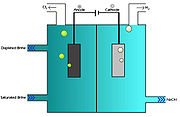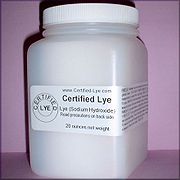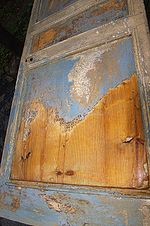CAUSTIC SODA also known as sodium hydroxide (NaOH) , is a caustic metallic base. It is used in many industries, mostly as a strong chemical base in the manufacture of pulp and paper, textiles, drinking water, soaps and detergents and as a drain cleaner. World-wide production in 1998 was around 45 million tonnes. Sodium hydroxide is a common base in chemical laboratories
Pure sodium hydroxide is a white solid; available in pearls, flakes, granules and as a 50% saturated solution. It is hygroscopic and readily absorbs water from the air, so it should be stored in an airtight container. It is very soluble in water with liberation of heat. It also dissolves in ethanol and methanol, though it exhibits lower solubility in these solvents than does potassium hydroxide. Molten sodium hydroxide is also a strong base, but the high temperature required limits applications. It is insoluble in ether and other non-polar solvents. A sodium hydroxide solution will leave a yellow stain on fabric and paper.
Physical properties
Δ H° dissolution for diluted aqueous -44.45 kJ / mol;
From aqueous solutions at 12.3-61.8°C, it crystallizes in monohydrate, with a melting point 65.1 °C and density of 1.829 g/cm 3;
Δ H° form -734.96 kJ / mol;
Monohydrate from -28 to -24°C;
Heptahydrate from -24 to -17.7°C;
Pentahydrate from -17.7 to -5.4°C;
Tetrahydrate (α- changed), at -5 , 4 - 12.3°C Also know metastable β- NaOH 4* H 2O. Which above 61.8°C are crystallized.
Chemical properties
Sodium hydroxide is completely ionic, containing sodium cations and hydroxide anions. The hydroxide anion makes sodium hydroxide a strong base which reacts with acids to form water and the corresponding salts, e.g. with hydrochloric acid, sodium chloride is formed:
NaOH( aq) + HCl(aq) → NaCl(aq) + H 2O( l)
In general such neutralization reactions are represented by one simple net ionic equation:
OH −(aq) + H +(aq) → H 2O(l)
This type of reaction with a strong acid releases heat, and hence is referred to as exothermic. Such acid-base reactions can also be used for titrations, which is a common method to determine the concentration of acids.
Another type of reaction that sodium hydroxide is involved in is with acidic oxides. The reaction of carbon dioxide has already been mentioned, but other acidic oxides such as sulfur dioxide (SO 2) also react completely. Such reactions are often used to " scrub" harmful acidic gases (like SO 2 and H 2S) and prevent their release into the atmosphere.
2 NaOH + CO 2 → Na 2CO 3 + H 2O
Sodium hydroxide slowly reacts with glass to form sodium silicate, so glass joints and stopcocks exposed to NaOH have a tendency to "freeze". Flasks and glass-lined chemical reactors are damaged by long exposure to hot sodium hydroxide, and the glass becomes frosted. Sodium hydroxide does not attack iron since iron does not have amphoteric properties. A few transition metals, however, may react with sodium hydroxide in a vigorous way.
In 1986, an aluminium road tanker in the UK was mistakenly used to transport 25% sodium hydroxide solution [ citation needed], causing pressurization of the contents and damage to the tanker. The pressurization was due to the hydrogen gas which is produced in the reaction between sodium hydroxide and aluminium:
2 Al(s) + 6 NaOH(aq) → 3 H 2(g) + 2 Na 3AlO 3(aq)
Unlike NaOH, the hydroxides of most metals are insoluble, and therefore sodium hydroxide can be used to precipitate metal hydroxides. One such hydroxide is aluminium hydroxide, used as a gelatinous flocculant to filter out particulate matter in water treatment. Aluminium hydroxide is prepared at the treatment plant from aluminium sulfate by reacting with NaOH. This reaction is highly profitable, and is hence an important synthesis reaction.
Sodium hydroxide reacts readily with carboxylic acids to form their salts and is even a strong enough base to form salts with phenols. NaOH can be used for the base-driven hydrolysis of esters (as in saponification), amides and alkyl halides. However, the limited solubility of NaOH in organic solvents means that the more soluble KOH is often preferred.
Manufacture
In 1998, total world production was around 45 million tonnes. North America and Asia collectively contributed around 14 million tonnes, while Europe produced around 10 million tonnes. In the United States, the major producer of sodium hydroxide is the Dow Chemical Company, which has annual production around 3.7 million tonnes from sites at Freeport, Texas, and Plaquemine, Louisiana. Other major US producers include Oxychem, PPG, Olin, Pioneer Companies (which was purchased by Olin), Inc. (PIONA), and . All of these companies use the chloralkali process
Methods of production

Basic membrane cell used in the electrolysis of brine.
Sodium hydroxide is produced (along with chlorine and hydrogen) via the chloralkali process. This involves the electrolysis of an aqueous solution of sodium chloride. The sodium hydroxide builds up at the cathode, where water is reduced to hydrogen gas and hydroxide ion:
2Na + + 2H 2O + 2e − → H 2 + 2NaOH
More accurately:
2Na +Cl - + 2H 2O + 2e − → H 2 + 2Cl - + 2NaOH
To produce NaOH it is necessary to prevent reaction of the NaOH with the chlorine. This is typically done in one of three ways, of which the membrane cell process is economically the most viable.
• Mercury cell process (also called the Castner-Kellner process); Sodium ions are reduced to sodium metal, which forms an amalgam with a mercury cathode; this sodium is then reacted with water to produce NaOH. There have been concerns about mercury releases, although modern plants claim to be safe in this regard.
• Diaphragm cell process; uses a steel cathode, and the reaction of NaOH with Cl2 is prevented using a porous diaphragm, often made of asbestos fibers. In the diaphragm cell process the anode area is separated from the cathode area by a permeable diaphragm. The brine is introduced into the anode compartment and flows through the diaphragm into the cathode compartment. A diluted caustic brine leaves the cell. The sodium hydroxide must usually be concentrated to 50% and the salt removed. This is done using an evaporative process with about three tonnes of steam per tonne of sodium hydroxide. The salt separated from the caustic brine can be used to saturate diluted brine. The chlorine contains oxygen and is purified by liquefaction and evaporation.
• Membrane cell process; similar to the diaphragm cell process, with a Nafion membrane to separate the cathode and anode reactions. Only sodium ions and a little water pass through the membrane. It produces a higher quality of NaOH. Of the three processes, the membrane cell process requires the lowest consumption of electric energy and the amount of steam needed for concentration of the caustic is relatively small (less than one tonne per tonne of sodium hydroxide).
An older method for sodium hydroxide production was the Leblanc process, which produced sodium carbonate, followed by roasting to create carbon dioxide and sodium oxide. This method is still occasionally used. It helped establish sodium hydroxide as an important commodity chemical.
The Leblanc process was superseded by the Solvay process in the late 19th century.
Uses
Sodium hydroxide is the principal strong base used in the chemical industry. In bulk it is most often handled as an aqueous solution, since solutions are cheaper and easier to handle. It is used to drive chemical reactions and also for the neutralization of acidic materials. It can be used also as a neutralizing agent in petroleum refining. It is also used for heavy duty and industrial cleaning

Canister of sodium hydroxide.
Alumina production
In the Bayer process, sodium hydroxide is used in the refining of alumina containing ore (bauxite) to produce alumina (aluminium oxide) which is the raw material used to produce aluminium metal via the electrolytic Hall-Héroult process.
Soap production
Sodium hydroxide is traditionally used in soap making (cold process soap, saponification).It was made in the nineteenth century for a hard surface rather than liquid product because it was easier to store and transship.
Oil drilling
Sodium hydroxide is used as an additive in drilling mud to increase alkalinity. This serves two functions. Firstly raising alkalinity in bentonite mud systems increases the mud viscosity. A secondary function of raising alkalinity is to neutralise any acid gas (such as hydrogen sulfide and carbon dioxide) which may be encountered in the geological formation as drilling progresses.
Fuel production
Sodium hydroxide can be added to poor quality crude oil to remove sulfurous impurities in a process known as caustic washing. The process forms a highly toxic waste containing hydrogen sulfide, organic disulfides and mercaptans.[7] Because of this the process is banned in many countries but in 2006, Trafigura used the process and then dumped the waste in Africa.
Pulp manufacturing for producing paper
Sodium hydroxide was also widely used in making paper. Along with sodium sulfide, NaOH is a key component of the white liquor solution used to separate lignin from cellulose fibers in the Kraft process. It also plays a key role in several later stages of the process of bleaching the brown pulp resulting from the pulping process. These stages include oxygen delignification, oxidative extraction, and simple extraction, all of which require a strong alkaline environment with a pH > 10.5 at the end of the stages.
Biodiesel
For the manufacture of biodiesel, sodium hydroxide is used as a catalyst for the transesterification of methanol and triglycerides. This only works with anhydrous sodium hydroxide, because combined with water the fat would turn into soap, which would be tainted with methanol. It is used more often than potassium hydroxide because it is cheaper and a smaller quantity is needed.
Aluminium etching
Strong bases attack aluminium. Sodium hydroxide reacts with aluminium and water to release hydrogen gas. The aluminium takes the oxygen atom from sodium hydroxide(NaOH), which in turn takes the oxygen atom from the water, and releases the two hydrogen atoms. In this reaction, sodium hydroxide acts as an active catalyst. This reaction can be useful in etching, removing anodizing, or converting a polished surface to a satin-like finish, but without further passivation such as anodizing or alodining the surface may become degraded, either under normal use or in severe atmospheric conditions.
Cleaning agent
Sodium hydroxide is frequently used as an industrial cleaning agent where it is often called "caustic". It is added to water, heated, and then used to clean the process equipment, storage tanks, etc. It can dissolve grease, oils, fats and protein based deposits. The sodium hydroxide solution can also be added surfactants to stabilize dissolved substances to prevent redeposition. A sodium hydroxide soak solution is used as a powerful degreaser on stainless and glass bakeware. It is also a common ingredient in oven cleaners.
Leaded Glass Window restoration
Sodium Hydroxide can be used to dissolve old "weatherproofing cement" in leaded glass windows by soaking the panels overnight in a solution of 1 pound Sodium hydroxide to 5 gallons of water.
Paint stripper

Paint stripping with caustic soda
A solution of sodium hydroxide in water was traditionally used as the most common paint stripper on wooden objects. Due to its caustic nature and the fact that it can damage the wood surface raising the grain and staining the color, its use has become less common.
Tissue digestion
This is a process that was used with farm animals at one time. This process involves the placing of a carcass into a sealed chamber, which then puts the carcass in a mixture of sodium hydroxide and water, which breaks chemical bonds keeping the body intact. This eventually turns the body into a coffee-like[clarification needed] liquid, and the only solid that remains are bone hulls, which could be crushed between one's fingertips.[9] Sodium hydroxide is frequently used in the process of decomposing roadkill dumped in landfills by animal disposal contractors[citation needed].
Sodium hydroxide has also been used by criminals to dispose of their victims' bodies
Food preparation
Food uses of sodium hydroxide include washing or chemical peeling of fruits and vegetables, chocolate and cocoa processing, caramel coloring production, poultry scalding, soft drink processing, and thickening ice cream. Olives are often soaked in sodium hydroxide to soften them, while pretzels and German lye rolls are glazed with a sodium hydroxide solution before baking to make them crisp. Due to the difficulty in obtaining food grade sodium hydroxide in small quantities for home use, Sodium carbonate is often used in place of sodium hydroxide
Specific foods processed with sodium hydroxide include:
• The Pinoy or Filipino kakanin called kutsinta have lye to jellify the kutsinta.
• Also the Filipino kakanin called pitsi-pitsi or pichi-pichi (pit-chi-pit-chi) also have a small amount of lye.
• The Scandinavian delicacy known as lutefisk (from lutfisk, "lye fish").
• Hominy is dried maize (corn) kernels reconstituted by soaking in lye-water. These expand considerably in size and may be further processed by frying to make corn nuts or by drying and grinding to make grits. Nixtamal is similar, but uses calcium hydroxide instead of sodium hydroxide.
• Sodium hydroxide is also the chemical that causes gelling of egg whites in the production of Century eggs.
• German pretzels are poached in a boiling sodium carbonate solution or cold sodium hydroxide solution before baking, which contributes to their unique crust.
• Most yellow coloured Chinese noodles are made with lye-water but are commonly mistaken for containing egg.
Domestic uses
Sodium hydroxide is used in the home as a drain cleaning agent for clearing clogged drains. It is distributed as a dry crystal or as a thick liquid gel. The chemical mechanism employed is the conversion of grease to a form of soap. Soap is water-soluble, and can be dissolved by flushing with water. This conversion occurs far more rapidly at high temperatures, so commercial drain cleaners may also contain chemicals that react with water to generate heat. Sodium hydroxide also decomposes complex molecules such as the protein that composes hair. Such drain cleaners (and their acidic versions) are highly caustic and should be handled with care.
Sodium hydroxide has been used as a relaxer to straighten hair. However, because of the high incidence and intensity of chemical burns, chemical relaxer manufacturers have now switched to other alkaline chemicals, although sodium hydroxide relaxers are still available, they are used mostly by professionals.
Use in chemical analysis
In analytical chemistry, sodium hydroxide solutions are often used to measure the concentration of acids by titration. Since NaOH is not a primary standard, solutions must first be standardised by titration against a standard such as KHP. Burettes exposed to NaOH should be rinsed out immediately after use to prevent "freezing" of the stopcock. Sodium hydroxide was traditionally used to test for cations in Qualitative Inorganic Analysis, as well as to provide alkaline media for some reactions that need it, such as the Biuret test.
Safety
Solid sodium hydroxide and solutions of more than 2% by weight (0.5 M) should be labeled as corrosive.
Chemical burn caused by exposure to a sodium hydroxide solution.
Solid sodium hydroxide or solutions of sodium hydroxide will cause chemical burns, permanent injury or scarring, and blindness if it contacts unprotected human or animal tissue. Protective equipment such as rubber gloves, safety clothing and eye protection should always be used when handling the material or its solutions.
Dissolution of sodium hydroxide is highly exothermic, and the resulting heat may cause heat burns or ignite flammables.
|